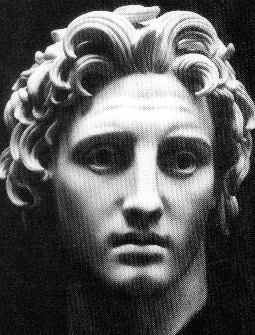
Alexander the Great.

Alexander the Great.
When speaking of art today, we think first of those forms which we
encounter every day, art forms which are familiar to us through the
media or through personal experience: film, theater, pop concerts. We
think, too, of contemporary painting, sculpture, and photography.
Over and over, television, radio and the newspapers tell us what is
modern in painting and sculpture, what is "in." The younger among us
are impressed, and convinced that all of what the media propagate is
really "great art," even though we do not care for it personally.
Moreover, this influencing of people's artistic values is inherent in
the freedom of our society. What art history will show to be lasting,
remains undetermined. Only subsequent generations will learn which
values in art really make an enduring contribution to human
development.
Ultimately, so-called contemporary art is only possible because art
and culture have a long development and tradition in the history of
humanity. A museum for European art in the United States has the
important task of drawing attention to the roots of art and culture,
to reveal the origins of cultural development in general, and with
respect to America and Europe in particular. Its job is to inform, so
that every observer can decide for himself what he considers art. It
has been said: "Listen to your own inner voice." It will tell you
what speaks to you and what pleases you."
The majority of U.S. citizens are descendants of Europeans. Their
thoughts, feelings and actions are backed by hundreds of years of
tradition and thousands of years of culture. This is true as well for
those who allow themselves to be overly influenced by fast-moving
modern development.
If we examine more closely the question of humanity's origins and
development, it is fascinating to discover how much agreement there
is among highly developed cultures on certain aesthetic questions.
This is true even where cultures developed that had no knowledge of
one another.
What we call European art and culture, that which comes out of
Europe, is not always purely European. Through trade, or even wars,
vastly different cultures have always influenced one another whenever
the bearers of these cultures came into contact with each other. We
know this from the cultural exchange between Europe and America after
the discovery of this continent. Even older is the cultural exchange
which took place during the time of Alexander the Great, when this
exceptional ruler built a world empire that extended from Greece over
Asia Minor and North Africa to India.
Not only Greek antiquity, but also Christianity and Judaism, have had
a marked influence on European culture. The fact that the noble
virtues of American Indians in Europe have also been viewed by
generations, especially young people, as worthy of emulation, is
likewise evidence that cultural values unite people.
The Museum of European Art in the United States will continue this
process. It should be proud of the cultural and artistic values which
its work promotes. It should be a place where the cultures of all
continents may meet. It should help to preserve the classical
artistic heritage of humanity, and it must promote a positive
understanding of art in which culture is a standard for all
people.